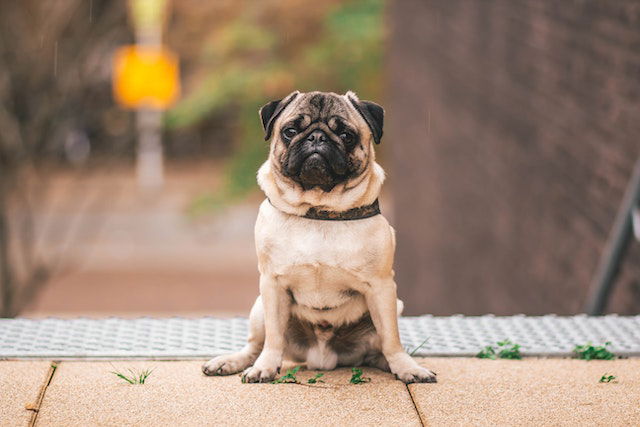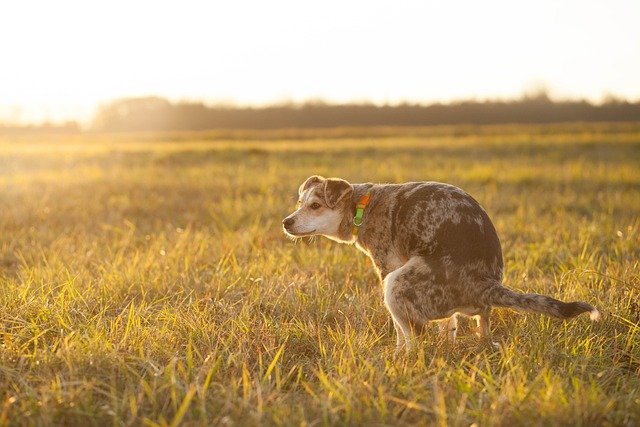We're an affiliate
We hope you love the products we recommend! Just so you know, we may collect a share of sales or other compensation from the links on this page at no additional cost to you. Thank you if you use our links, we really appreciate it!
How long can a dog go without pooping? If you have this question in mind, you’re in the right place to get all the answers you need.
As a responsible dog owner, you need to know your dog’s bowel movements since it will help you discover the signs of canine constipation and other digestive issues.
Keep reading this post as we look into the frequency of bowel movements in dogs, what is considered normal, and when it should raise concerns.
Watch out for our practical tips for preventing and managing constipation in dogs, and when you need to see a vet for specialized treatment.
How Often Do Dogs Poop?
In most cases, adult dogs in good health should poop between 1 to 3 times a day, and puppies can have normal bowel movements of up to 5 times a day. Senior dogs may take their bathroom break once a day or even less.

However, the frequency of waste elimination is not standard for all dogs and it is perfectly normal to experience minor variations based on several factors.
6 Factors Affecting the Frequency of Bowel Movements in Dogs
The following are some of the factors that may affect how often your dog makes a long call:
1. Diet and nutrition
The type, quality, and amount of food your dog consumes in a day has a direct impact on how often they produce stool.
A well-balanced dog’s diet with high-quality food is not only beneficial for their well-being, but it also dictates how often your dog would eliminate waste.
Dogs on a regular fiber-rich diet will have a consistent bowel movement since the nutrients support healthy digestion and prevent constipation.
In terms of the meal size, the more your dog eats, the more frequently you can expect them to leave poop behind.
Large food portions can be risky for your dog since it may propel them into obesity which then results in several chronic health conditions.
2. Age and size of the dog
Puppies have more frequent bathroom breaks than adult dogs because they have a faster metabolism rate.
The intestinal tract in young dogs is still developing, and they process food very quickly and sometimes they do not digest it thoroughly.
Generally speaking, if a dog is younger, food will move faster through their digestive tract, and this leads to increased pooping.
In terms of the size of the dog, large breeds tend to eliminate a large volume of stool with less frequent bowel movements.
Small breeds on the other hand will eliminate small volumes of stool with frequent visits to the bathroom.
3. The activity level of the dog
Active dogs who take part in physical exercise tend to have healthy and regular bowel movements compared to docile dogs.

Frequent physical stimulation improves digestion and this has a direct impact on how often the dog would eliminate waste.
4. The dog’s medical condition
Dogs with health problems may show some of the effects on bowel movements. Digestive health conditions like irritable bowel disease may experience frequent pooping through diarrhea.
The consistency and appearance of stool from a dog with health problems are also an indicator of their condition.
They may expel watery stools, vomit, and leave accidental messes on the floor despite being housetrained.
5. Drugs and medication
Some canine medicines may alter the frequency of bowel movement alongside other side effects. Make sure to ask your vet about the possible side effects of all drugs administered to your dog.
6. Stress and anxiety
If your furry friend is experiencing chronic emotional distress, they may end up making frequent trips to the bathroom.
Your dog’s digestive system will have increased nerve activity when they feel nervous or stressed out due to the increase of stress hormones.
This makes the blood move away from the intestines exposing the dog to vomiting and diarrhea.
Typical Appearance of Normal Dog Poop
You should pay attention to your dog’s waste and understand what a healthy poop should look like. This will help you discover when your dog is suffering from digestion issues.
1. Color
The normal color of healthy poop in dogs should be chocolate brown or brownish, and this is an indicator of good gut health.
You may experience slight variations in the color depending on what your dog ate and their health conditions.
Green-colored poop is a common sign that the dog has ingested too much grass. In some cases, the green color may indicate internal parasites in dogs or they have gall bladder issues.
2. Consistency
Healthy dog poop should have a compact consistency, moist, squishable (like Play-Doh), and easy to pick up from any surface.
Watery stool and diarrhea in dogs are indicators of intestinal upset. A small rock-like stool is a sign that your dog is dehydrated or constipated.
3. Odor
Healthy dog poop should have a mild noticeable odor without any foul smell. Stinky poop in dogs could be an indicator of changes in their gut’s flora, or they’re struggling to adjust to a new diet.
What Healthy Dog Poop Looks Like
So, what’s the ideal poop appearance of a healthy dog? It should be chocolate brown, compact but a bit squishy when picked, in one log-like piece, and proportionate to your dog’s serving. It should have a mild odor, without any foul-smelling components.
How Long Can a Dog Go Without Pooping Before It Becomes Dangerous?
For the most part, adult dogs in good health conditions can go up to 48 hours without elimination, and sometimes even longer for senior dogs.
If your dog has not had bowel activity for more than 2 or 3 days, it should cause serious concern and you should take action immediately.
We recommend taking your dog for a medical examination at the vet’s office to rule out any health condition and offer prompt treatment if needed.
How Long Can a Puppy Go Without Pooping?
Puppies make frequent calls to the bathroom more than their adult counterparts, depending on age, and the environment.
However, if your puppy is approaching the 48 hours mark without pooping, you should take immediate action to investigate the problem.
What Is Constipation in Dogs?
Constipation is a temporary health condition that refers to infrequent bowel movements and difficulty in the elimination of stool.
A constipated dog will strain to poop and experience pain when passing the pellet-like stool from their rectal column.
A severe form of constipation is known as obstipation – it is more permanent and associated with an irreversible medical condition where the dog completely fails to pass stool.
Causes Of Constipation in Dogs
There are many potential factors that may cause constipation in dogs, but the most common one is ingestion of non-food items which causes intestinal blockage.
Long-furred dogs and those who are prone to excessive self-grooming are at a higher risk of ingesting hair in the process and becoming constipated.
The other factors that may cause constipation in dogs include:
- Age
- Lack of enough water intake
- Inadequate fiber intake
- Inadequate physical activities or lack of exercises
- Medical conditions in the colon such as tumors
- Medication such as antihistamines, diuretics
- Hormonal diseases such as hypothyroidism
- Abrupt changes in diet or introduction of new ingredients (especially human foods)
Symptoms Of Constipation in Dogs
The first noticeable symptom of constipation in dogs is the infrequent bowel movements and difficulty in passing stool. You can tell if your dog is constipated when they strain to go several times without success.
Some constipated dogs would drag their bottoms along the ground (scooting) as a way of relieving irritation.

The other symptoms include the passing of dry pebble-like stool which is also an indicator of dehydration or lack of fiber intake.
Constipated dogs also show decreased appetite and vomiting due to digestive disturbance, and they may experience sudden weight loss.
Managing And Preventing Constipation in Dogs
Constipation is uncomfortable, painful, and irritative to dogs. It is a good idea to take your dog to the vet for diagnosis as soon as you suspect the problem.
The following are some of the practical approaches you can adopt at home to prevent your furry friend from constipating:
Changing the dog’s diet
Provide your dog with high-quality dog-specific foods for their overall health and nutritional support.
Remember to add fiber-rich foods to your dog’s daily portion to support healthy digestion and normal bowel movements.
It’s a good idea to increase your dog’s moisture intake by serving them wet foods to prevent constipation.
Home remedies for dogs with constipation
- Making pumpkin puree for your constipating dog is a good idea because the food is rich in fiber and has lots of moisture. Don’t give your dog pumpkin pie filling because they are made with high sugar content and too many artificial additives.
- Consider adding a few dietary fiber supplements to your dog’s main meal. This will improve your dog’s digestion and manage a healthy bowel movement. Always consult with your vet before starting your dog on any supplement.
- Get some soft canned dog foods with high moisture content to regulate your dog’s digestive tract. Such foods will help in forming a softer stool which becomes much easier to eliminate. We recommend mixing canned dog food with the main meal to prevent digestive irritation.
- Make sure to provide enough clean drinking water to your dog for proper hydration and you may also add some electrolyte supplements.
- Exercise your dog. Slot in some time every day to take your dog for walks and runs across the neighborhood. Subjecting your furry friend to physical activities promotes healthy digestion and decreases the chances of constipation.
When To Seek Veterinary Care
Mild constipation during the early stages can be managed at home with proper care.
However, if your constipating dog does not show any improvement despite changing their diet for more than 48 hours, then you should call the vet.
Other occasions that warrant attention from the vet are when your affected pup is experiencing pain and discomfort when trying to eliminate poop.
If possible, you can collect a sample of your dog’s stool in a clean poop bag and take it to the vet’s office for identification of possible components.
Diagnosis Of Constipation in Dogs
Constipating dogs are diagnosed through physical examination and scrutiny of their medical history. An abdominal radiograph (X-rays) may be done to search for obstructions in the gastrointestinal tract.
Your vet may also carry out a rectal examination to rule out anal strictures or any other irregularity in your dog’s rectum. A biopsy may be recommended to ascertain the presence of strictures in the rectum.
The vet may carry out blood work and urine analysis to diagnose dehydration or possible infections
How To Make a Dog Poop Quickly
In addition to providing your dog with the appropriate diet, water intake, and providing exercises, you can induce them to poop quickly by gently rubbing their belly.
Massaging the belly may stimulate the gastrointestinal muscles and encourage the dog to make a move to the bathroom.

You can also consider training your dog on basic commands when they go to eliminate and reward them with a tasty treat when they finish the business.
This will make your furry friend responsive to your commands when you feel like they need to take a bathroom break, especially before sleeping.
Frequently Asked Questions (FAQs)
1. What should I do if my dog hasn’t pooped in 3 days?
It’s best to take them to the vet immediately for examination and prompt treatment. Dogs can stay for up to 48 hours without any bowel activity, but 3 days is long overdue and it therefore requires your concern.
2. Can a dog die from not pooping?
Unfortunately, yes! Dogs can indeed die because of being unable to eliminate waste. In most cases, this is because of a build-up of constipation which causes severe obstipation.
Other chronic illnesses in dogs may affect their bowel activity and cause fatalities. Sometimes rectal diseases and inflammation of the anus may make it very painful for dogs to poop to the extent of causing death.
3. Can certain dog breeds be more prone to constipation?
While all dog breeds are at risk of getting constipation, this condition is highly likely to affect specific dog breeds with certain traits.
Long-furred dog breeds are more likely to lick and ingest tiny pieces of hair causing blockage and constipation.
The hair around the bottom part may also become matted to cover the anus which is irritating when passing stool.
Anal gland diseases are common in small dog breeds, and this may induce them to infrequent bowel movements.
German shepherds have been identified as highly likely to get canine constipation more than other breeds because they are known to suffer perianal fistula (anal furunculosis).
Conclusion
Dogs can go up to 48 hours without pooping with a few more hours for senior dogs and a bit less for puppies.
When a dog goes for more than two days without any bowel activity, or they’re straining to eliminate, you should take concern and visit the vet for a medical examination.
Providing your dog with high-quality moist canine foods with sufficient fiber is enough to support healthy digestion and soft stool production.
Laura is the founder of Furs'n'Paws. She is a also a pet writer and expert with more than 20 years of experience of working with dogs and cats. She developed a very strong love for animals at a young age. Her passion led her to establish a thriving pet sitting and dog walking business in Dubai. As an expert in pet training, behavior, and nutrition, Laura is committed to helping pet owners and pet lovers by offering high-quality information on a wide range of topics.




No responses yet